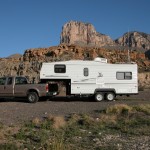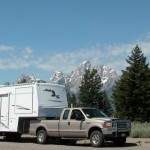For years, the urge to ditch our old lifestyle and hit the road as full-time RVers nagged at us. Sell the house, downsize our belongings, and live the simple life became our mantra. But did we have the courage to chuck it all after 40 years in the Denver area and 30 years in the house where we raised our kids? Certainly we didn’t want to make the leap without having a purpose for our travels.

Although we’d camped for years in tents, tent trailers, and a truck camper, our first liveable RV was a 21 foot Nash fifth wheel. As we toured in this trailer, we imagined life on the road where home was wherever we parked – no need to consider return trips, merely the next destination. We envisioned freedom from yard chores, anticipted new horizons, and expected exciting experiences. Still, we were reluctant to switch gears without first testing this way of life. After all, the grass is not always greener on the other side. And our paid-off 3-bedroom ranch was perfect for a couple entering retirement years.
The Test
Perhaps our hesitation stemmed from our long-time volunteer work at the Denver Zoo. Fifteen years as docents had been stimulating and educational, but if we couldn’t meet our yearly hour requirements while on the road, we could no longer participate at the zoo.
Or perhaps we vacillated because of our snakes. How could we travel in an RV with four snakes and their cages? We’d begun volunteering as naturalists at a Colorado state park near our home several years before taking to the road, and we presented programs to local schools and the park’s campground amphitheater with these critters. We enjoyed our work as naturalists and docents and were reluctant to abandon it.
“How about this?” Chuck said as he emerged from his den one fall evening in 2005. “A national wildlife refuge in Arizona is looking for a volunteer couple to help with school programs and lead hikes in the desert this winter.”
By now we’d traded in our small fifth wheel for a 27 foot Arctic Fox fifth wheel that would be adequate to live in for months at a time. This could be our opportunity to experience the new life, yet pursue our passion as naturalists and maintain a purpose.

When our resume was accepted, we learned that we were welcome to bring the snakes to use them in programs at our discretion and display them at the visitor center. We packed the trailer, closed the house, and headed south with four snakes, not knowing, or maybe not even caring, what lay ahead.
Remote
Imperial National Wildlife Refuge lies 40 miles north of Yuma, Arizona, along the Colorado River, butting up against the Sonoran Desert. Barren terrain along US-95 introduced us to the remoteness of the area. What have we gotten ourselves into? we wondered with escalating skepticism.
After 30 miles of what we considered desolate landscape, we turned onto Martinez Lake Road to drive another 10 miles towards the tiny town of Martinez Lake. Increasingly, we questioned our sanity that removed us from an urban/suburban comfort zone to live for several months in a remote section of a desert that we knew nothing about. By the time we drove an additional three miles to arrive at Imperial National Wildlife Refuge’s visitor center, we were apprehensive, in the beginning stages of homesickness, and perhaps leery of our judgement.
What we did know was that this could be the longest stretch of our lives. What we didn’t know was that it was the beginning of a new life.
